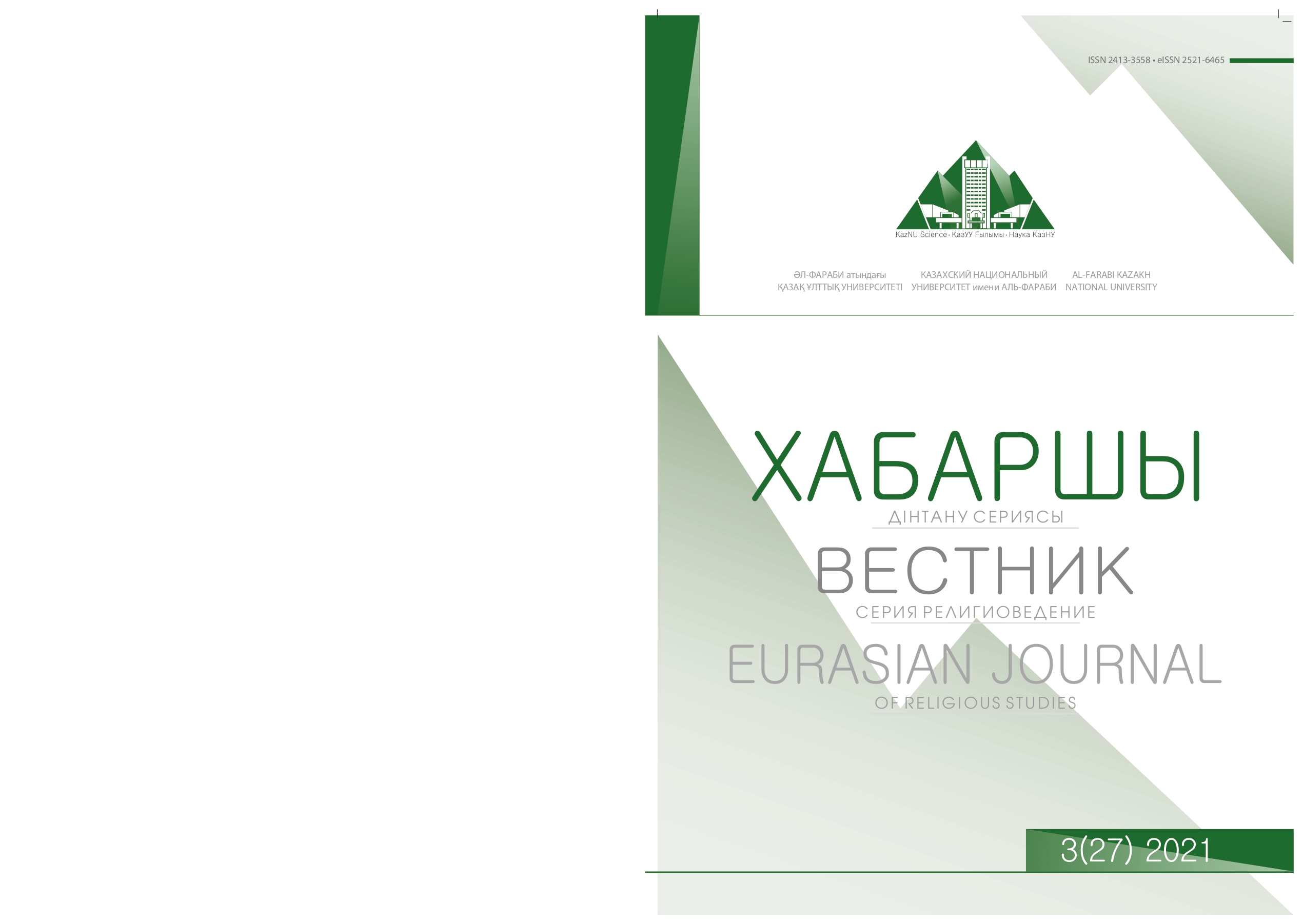Pilgrimage in Kazakhstan: the graves of the Sufi sheikhs
DOI:
https://doi.org/10.26577//EJRS.2021.v27.i3.r6Keywords:
graves of Sufis, ziryats of Sheikhs, pilgrimage, auliya, mausoleumAbstract
Places of pilgrimage in Sufism are shrines dedicated to various Sufi saints - spiritually elevated ascetics from various mystical orders in Islam. The purpose of the pilgrimage (ziyarat) to the graves of saints is to receive grace and protection from the saint. When making ziyarat to the saints, Muslims read suras from the Koran near the grave, make a ritual circumambulation around it (tawaf), and make sacrifices. In some countries, the local shrine is the center of the community. The tombs erected over the graves of the saints become the centers of the "sacred" cities (al-Najaf and Karbala in Iraq, Mashhad in Iran, Mazar-i-Sharif in Afghanistan, the Mausoleum of Najimetdin Kubra in Turkmenistan, and the Mausoleum of Khoja Ahmed Yasavi in Turkestan). This article is devoted to the consideration of the traditions associated with the burial monuments of Sufi sheikhs in Kazakhstan. Sufism has gained widespread popularity since the time of the Golden Horde. To date, archaeological evidence testifies to the early spread of Sufism, mainly in the southern and western regions of the country. The southern regions are traditionally centers of pilgrimage. More than 300 auliya graves are located in the western region. Ethnographic studies of the graves of Sufi sheikhs in the Akmola region testify to the spread of Sufi teachings in the northern regions of Kazakhstan.
Keywords: graves of Sufis, ziryats of Sheikhs, pilgrimage, auliya, mausoleum
References
Кныш, А. Д.; пер. с англ. М. Г. Романов (2004) Мусульманскиы миститсизм: краткая история /. – СПб.: «Издательство «ДИЛЯ». – 464.
Муминов, А. (2014) Суфиыскиые группы в современном Казакхстане, е-Ислам. [Електронныы ресурс]. URL: http://e-islam.kz/ru/qazaqstandagy-islam/vnutrennie-kategorii/islam-zh-nindegi-zertteuler/item/5614-cufijskie-gruppy-v-sovremennom-kazakhstane.
Нуртазина, Н. (2009) Религиозныы туризм: история и современныые проблемы. На пути к святыням: культ и культура. – Алматы: Соврем. проблемы сервиса и туризма. – 25-37.
Покидаыев Д. (2019) Сакральная карта Казакхстана об`ыединяыет болеые 600 об"ыектов. [Електронныы ресурс]. URL: https://kursiv.kz/news/obschestvo/2019-01/sakralnaya-karta-kazakhstana-obedinyaet-bolee-600-obektov
Фестиваль «Накшбандия» проыдет в Узбекистане. https://www.gazeta.uz/ru/2018/11/06/tourism/
References
Abdul'vapov, N. (2006) Rol' sufiyskoy obiteli v formirovanii i razvitii tyurkoyazychnoy religiozno-sufiyskoy poezii (na primere literatury osmanskogo regiona). Voprosy krymskotatarskoy filologii, istorii i kul'tury [The role of the Sufi monastery in the formation and development of the Turkic-speaking religious-Sufi poezii (on the example of the literature of the Ottoman region). Issues of Crimean Tatar Philology, History and Culture]. – Симферополь: Gosudarstvennoye byudzhetnoye obrazovatel'noye uchrezhdeniye vysshego obrazovaniya Respubliki Krym "Krymskiy inzhenerno-pedagogicheskiy universitet imeni Fevzi Yakubova". – 61-74. (in Russian)
Ali Gomaa. (2011) Salafi destruction of shrines and public property unacceptable. [Elektronnyy resurs]. URL: https://en.wikipedia.org/wiki/Persecution_of_Sufis
Festival' «Nakshbandiya» proydet v Uzbekistane. https://www.gazeta.uz/ru/2018/11/06/tourism/ (in Russian)
Knysh, A. D.; per. s angl. M. G. Romanov (2004) Musul'manskiy mistitsizm: kratkaya istoriya /. – SPb.: «Izdatel'stvo «DILYA». – 464. (in Russian)
Muminov, A. (2014) Sufiyskiye gruppy v sovremennom Kazakhstane, e-Islam. [Elektronnyy resurs]. URL: http://e-islam.kz/ru/qazaqstandagy-islam/vnutrennie-kategorii/islam-zh-nindegi-zertteuler/item/5614-cufijskie-gruppy-v-sovremennom-kazakhstane. (in Russian)
Muslim ibn al'-Khadzhzhadzh. Sakhikh Muslim. – T. 2. – 672. [Elektronnyy resurs]. URL: https://ru.wikipedia.org/wiki/%D0%9F%D0%BE%D1%87%D0%B8%D1%82%D0%B0%D0%BD%D0%B8%D0%B5_%D0%BC%D0%BE%D0%B3%D0%B8%D0%BB_%D0%B2_%D0%B8%D1%81%D0%BB%D0%B0%D0%BC%D0%B5#cite_note-3 (in Arabic)
Nurtazina, N. (2009) Religioznyy turizm: istoriya i sovremennyye problemy. Na puti k svyatynyam: kul't i kul'tura [Religious tourism: history and modern problems. On the way to shrines: cult and culture]. – Аlmaty: Sovrem. problemy servisa i turizma. – 25-37. (in Russian)
Pokidayev D. (2019) Sakral'naya karta Kazakhstana ob`yedinyayet boleye 600 ob"yektov. [The sacred map of Kazakkhstan consumes more than 600 objects]. URL: https://kursiv.kz/news/obschestvo/2019-01/sakralnaya-karta-kazakhstana-obedinyaet-bolee-600-obektov (in Russian)
Temirbayev, A. et al. (2019) Sufi educational practices in modern Kazakhstan: past and present. «Adam alemi». 4 (82). – 112-117.
Temirbayev, A. et al. (2021) Sufi practices in modern Kazakhstan: traditions and innovations, Central Asia and the Caucasus. Volume 24, Issue 1. – 91-98. DOI: https://doi.org/10.37178/ca-c.21.1.08.
Volkonskiy, M., Yarlykapov, A. (2020) Ural'skiy istoricheskiy vestnik. №2 (67) 2020. Мoskva izdatel'skiy dom Mardzhani. – 61-70. DOI: https://doi.org/10.30759/1728-9718-2020-2(67)-61-70. (in Russian)




